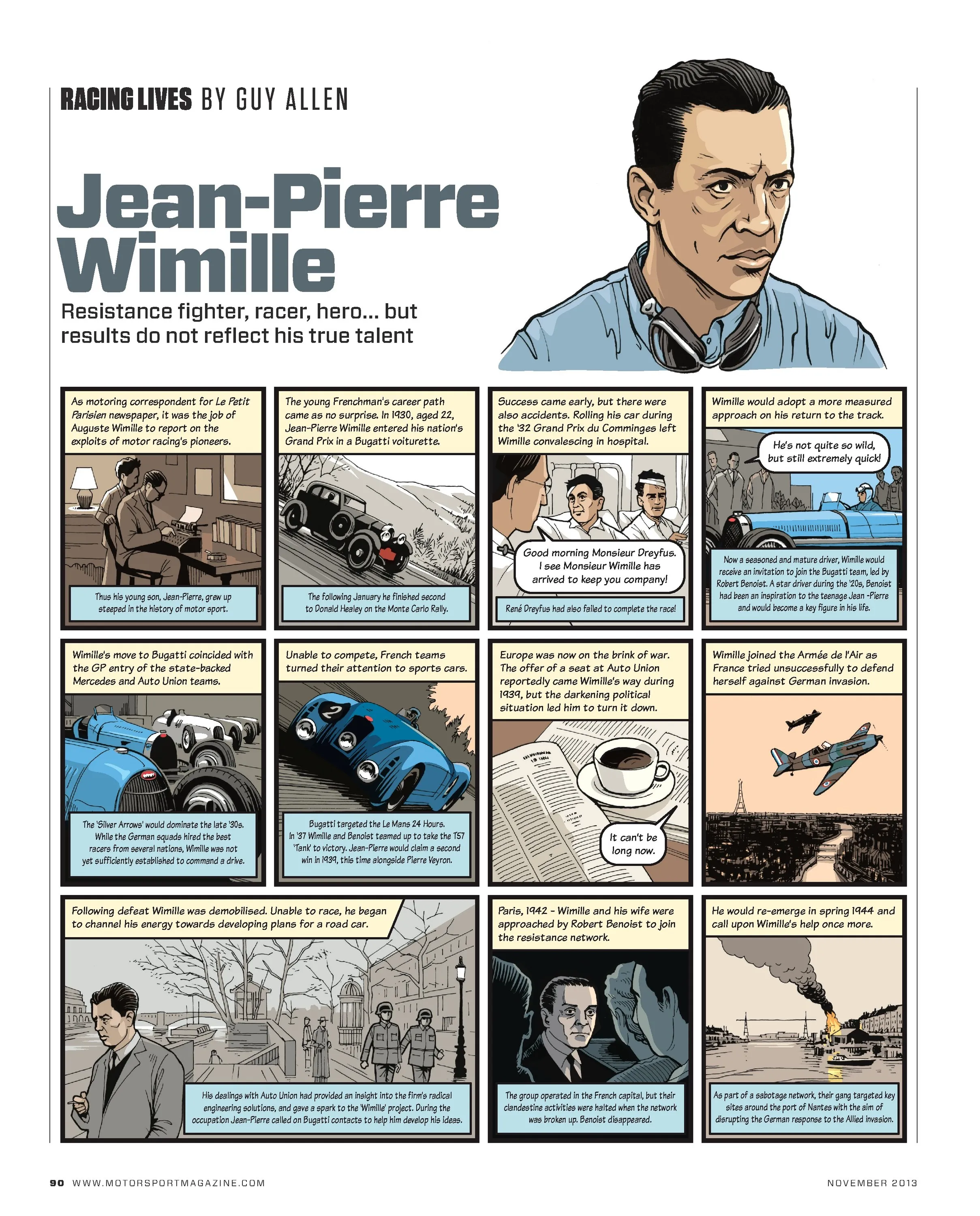Bottom post of the previous page:
On this day in Motor Racing's past
- erwin greven
- Staff

- Posts: 20086
- Joined: 19 years ago
- Real Name: Erwin Greven
- Favourite Motorsport: Endurance Racing
- Favourite Racing Car: Lancia Delta 038 S4 Group B
- Favourite Driver: Ronnie Peterson
- Favourite Circuit: Nuerburgring Nordschleife
- Car(s) Currently Owned: Peugeot 206 SW Air-Line 3 2007
- Location: Stadskanaal, Groningen
- Contact:
Brian Redman: "Mr. Fangio, how do you come so fast?" "More throttle, less brakes...."
- PTRACER
- Forum Administrator

- Posts: 42160
- Joined: 20 years ago
- Real Name: Paul
- Favourite Motorsport: Formula 1
- Favourite Racing Car: Lotus 49
- Favourite Driver: Gilles Villeneuve, James Hunt
- Favourite Circuit: Nordschleife
- Car(s) Currently Owned: Mitsubishi Lancer Evo X JDM
- Contact:
This was the scariest incident I've seen since Luciano Burti in 2001. Seeing the car all burned and charred like that is also really creepy somehow.
Developer of the 1967v3 Historic Mod for Grand Prix Legends: viewtopic.php?t=17429
King of the Race Track, Destroyer of Tyres, Breaker of Lap Records
King of the Race Track, Destroyer of Tyres, Breaker of Lap Records
- erwin greven
- Staff

- Posts: 20086
- Joined: 19 years ago
- Real Name: Erwin Greven
- Favourite Motorsport: Endurance Racing
- Favourite Racing Car: Lancia Delta 038 S4 Group B
- Favourite Driver: Ronnie Peterson
- Favourite Circuit: Nuerburgring Nordschleife
- Car(s) Currently Owned: Peugeot 206 SW Air-Line 3 2007
- Location: Stadskanaal, Groningen
- Contact:
A day too late, but not less meant:
Brian Redman: "Mr. Fangio, how do you come so fast?" "More throttle, less brakes...."
- Michael Ferner
- Senior Member

- Posts: 3531
- Joined: 7 years ago
- Real Name: Michael Ferner
- Favourite Racing Car: Miller '122', McLaren M23
- Favourite Driver: Billy Winn, Bruce McLaren
- Car(s) Currently Owned: None
- Location: Bitburg, Germany
A career of poor choices? Hmm. After a so-and-so career in F2, he ditched a poor F1 car for a better one, made enough of an impression to attract the attention of a two-time World Champion team, took a break from F1 to win the CanAm series (twice!), made another backmarker team run well on occasion, ditched another no-hoper and found employment with Ferrari and then Renault - it's hard to think of a poor choice in between there. Okay, he made a habit of not really delivering when it mattered most, but I doubt that was any of his 'choices'...
2023 'Guess The Pole' Points & Accuracy Champion
If you don't vote now against fascism, you may never have that chance again...
If you don't vote now against fascism, you may never have that chance again...
Ceterum censeo interruptiones essent delendam.
- PTRACER
- Forum Administrator

- Posts: 42160
- Joined: 20 years ago
- Real Name: Paul
- Favourite Motorsport: Formula 1
- Favourite Racing Car: Lotus 49
- Favourite Driver: Gilles Villeneuve, James Hunt
- Favourite Circuit: Nordschleife
- Car(s) Currently Owned: Mitsubishi Lancer Evo X JDM
- Contact:
I know Tambay won a few in 1983, a season I know next to nothing about, but have on DVD. At some point I'd like to watch the races and see how he did it.
Developer of the 1967v3 Historic Mod for Grand Prix Legends: viewtopic.php?t=17429
King of the Race Track, Destroyer of Tyres, Breaker of Lap Records
King of the Race Track, Destroyer of Tyres, Breaker of Lap Records
- EB
- Advanced Member

- Posts: 1503
- Joined: 18 years ago
He generally outdrove Arnoux iirc.
And if you attach the last half of 1982 to the first half of 1983, Tambay is the 82/83 world champion.
And if you attach the last half of 1982 to the first half of 1983, Tambay is the 82/83 world champion.
- Michael Ferner
- Senior Member

- Posts: 3531
- Joined: 7 years ago
- Real Name: Michael Ferner
- Favourite Racing Car: Miller '122', McLaren M23
- Favourite Driver: Billy Winn, Bruce McLaren
- Car(s) Currently Owned: None
- Location: Bitburg, Germany
As an Arnoux fan then, I must admit that he did awfully well against Renééééé... although I wouldn't say he generally outdrove him. More like a 4-5, but it was too close for comfort! 
Hey Ian, while you're here... I still read some of the threads on that other forum although I can no longer post, re: "Crazy F1 stats" - Can you ask poster Rob G what Fangio was doing at Silverstone on July 16 in 1955? Was he there before or after finishing second at Aintree?

Hey Ian, while you're here... I still read some of the threads on that other forum although I can no longer post, re: "Crazy F1 stats" - Can you ask poster Rob G what Fangio was doing at Silverstone on July 16 in 1955? Was he there before or after finishing second at Aintree?
2023 'Guess The Pole' Points & Accuracy Champion
If you don't vote now against fascism, you may never have that chance again...
If you don't vote now against fascism, you may never have that chance again...
Ceterum censeo interruptiones essent delendam.
- EB
- Advanced Member

- Posts: 1503
- Joined: 18 years ago
My initial reply to him did correct him on that, but I deleted it after he edited his post as I thought it unfair to kick him while he was downMichael Ferner wrote: ↑4 months ago Can you ask poster Rob G what Fangio was doing at Silverstone on July 16 in 1955? Was he there before or after finishing second at Aintree?

What got you banned from there? Too knowledgeable?
- Michael Ferner
- Senior Member

- Posts: 3531
- Joined: 7 years ago
- Real Name: Michael Ferner
- Favourite Racing Car: Miller '122', McLaren M23
- Favourite Driver: Billy Winn, Bruce McLaren
- Car(s) Currently Owned: None
- Location: Bitburg, Germany
Nothing. Some imbecile of a moderator accused me of "trolling and flame baiting", and that was that. I probably failed to kiss his ass. 
2023 'Guess The Pole' Points & Accuracy Champion
If you don't vote now against fascism, you may never have that chance again...
If you don't vote now against fascism, you may never have that chance again...
Ceterum censeo interruptiones essent delendam.
- EB
- Advanced Member

- Posts: 1503
- Joined: 18 years ago
It harms the forum more than it harms you, but hey I suppose they must know best, right?
- Michael Ferner
- Senior Member

- Posts: 3531
- Joined: 7 years ago
- Real Name: Michael Ferner
- Favourite Racing Car: Miller '122', McLaren M23
- Favourite Driver: Billy Winn, Bruce McLaren
- Car(s) Currently Owned: None
- Location: Bitburg, Germany
Thanks for saying it out loud... 

2023 'Guess The Pole' Points & Accuracy Champion
If you don't vote now against fascism, you may never have that chance again...
If you don't vote now against fascism, you may never have that chance again...
Ceterum censeo interruptiones essent delendam.
- Everso Biggyballies
- Legendary Member

- Posts: 49403
- Joined: 18 years ago
- Real Name: Chris
- Favourite Motorsport: Anything that goes left and right.
- Favourite Racing Car: Too Many to mention
- Favourite Driver: Kimi,Niki,Jim(none called Michael)
- Favourite Circuit: Nordschleife, Spa, Mt Panorama.
- Car(s) Currently Owned: Audi SQ5 3.0L V6 TwinTurbo
- Location: Just moved 3 klms further away so now 11 klms from Albert Park, Melbourne.
On This Day
18th january 1950
Gilles Villeneuve was born.
(It was also my late Father's Birthday....today would have been his 98th. He was around for 93 of them.He was also a Gilles Fan)
Its been a while since I added anything in here , so, as today is Gilles Villeneuves Birthday seems a good opportunity to add something. I was reading this article about Gilles by Mark Hughes who writes to dispell the myth that Gilles frequently crashed, and indeed justifies some of those we all remember, like at Zandvoort. As a Gilles fan back in the day of course it was a must read article. I know we have other Gilles fans here (including our Emperor @PTRACER ) so here is the article, from the Motorsport Magazine archives just over 20 years ago.
Many of the actual tales here are well known, but told in a different way. There are some
Gilles Villenueve: A reckless reputation undeserved
Gilles Villeneuve was much more than a brilliant but flawed racer. Look beyond the popular myths, says Mark Hughes, and the evidence points to a style that was precise and an approach that was measured
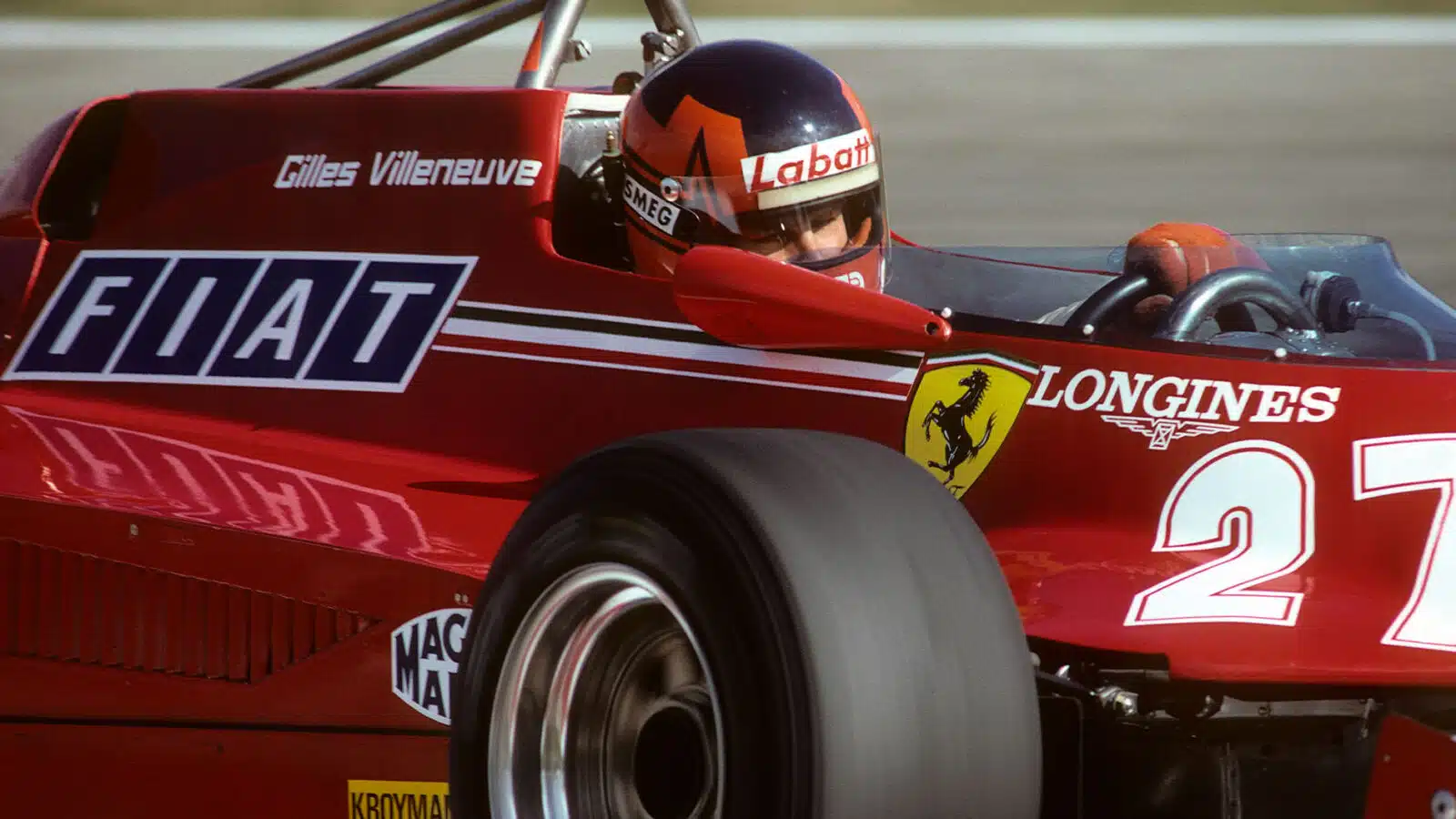
Hughes argues that the common Villeneuve perception is unmerited
A long time ago there was a racing driver, a fantastic driver, who did many impossible things. He took his first GP victory — at the end of his first full season — by choosing a compound his tyre supplier said was way too soft. But he knew better; he had an uncanny feel for how to nurse the rubber but still conjure winning speed from it. His team-mate, renowned as one of the most sensitive drivers of all lime, knew he couldn’t make these tyres last, opted for the harder ones — and finished third.
The driver took his next victory early the following season by pushing his new team-mate hard enough to make him overwork his tyres. That done, he simply glided past and reeled off the remaining laps, untroubled, serene.
He took his third victory in the very next race by going a whole compound softer than his team-mate. Again, the tyre men drew sharp breaths and shook their heads. Again he confounded them, winning by over half a minute.
In the last race of that season he took win number four. This time he had to conserve a sick engine, its oil pressure almost non-existent for the last 20 laps.
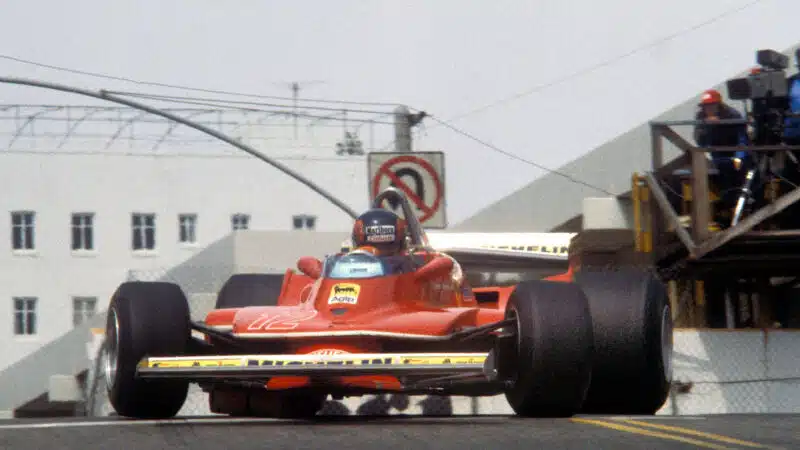
Gilles Villeneuve Ferrari US GP West Long Beach 1979
Villeneuve had a reputation for going sideways – as well as fast
Who was this angel of simpatico with the touch of silk? Gilles Villeneuve, that’s who. Surely not? This is the man once described by Enzo Ferrari as “a high priest of destruction”, isn’t it?
The very same. It’s the driver, one of the fastest and most spectacular of all time, whose image is forever captured in racing minds for three-wheeling back to the pits at Zandvoort, or sitting in the middle of the track at Imola with not a wheel on his smouldering wreck.
The paradox is only superficial. Villeneuve was one of the greatest drivers the world has ever seen, of a calibre that comfortably compares to such accepted greats such as a Senna, Clark, Schumacher, Fangio or Moss. That’s not the general perception, because his life was cut short before the overwhelming glories that were his due ever got to play out. But it’s the reality. Look beneath the surface, beneath the snapshots of drama that have lasted more vividly than the subtleties, and the evidence is overwhelming.
Mauro Forghieri described Gilles as having a “rage to win” greater than any driver he had known, and it was this competitive intensity that drove him on. And that, allied to a twist of DNA, allowed him impossible victories like Monaco or Jarama 1981. It was this same rage, however, that sparked incident and spectacle when in 1980-81, at a time his career should have been coming into full flower, Ferrari provided him with dogs.
“He was an innocent believer,” says Forghieri. “He had surrendered his own chances [of the world championship] for the team in 1979 with Scheckter, and he believed that he would be paid back.” When circumstances conspired against that, desperation occasionally surfaced.
But what about before 1980-81? There was incident then, too, surely? Villeneuve’s close friend and fellow GP driver, Bruno Giacomelli, puts that into perspective: “You have to make the distinction between early in his career and later. Those who talk about Gilles as crazy, I think they got it wrong. You must remember that he had no real experience when he first came into F1. I mean, he didn’t even have international experience, just Formula Atlantic in Canada and North America. He had to learn so much more than the rest of us brought up on racing in Europe. If you think, he came to F1 without any international experience, he had to learn the tracks as well as all about F1 and with all the pressure of being a Ferrari driver.
“Of course he made mistakes! There were only two possible outcomes in that situation, no matter how talented you were. You would either not have been quick enough or you would have accidents. And if you’re not quick enough, you’re not going to get to stay in F1. So there was only one option. I think he did incredibly well. Jesus, he almost won one of his first races!” That would be Long Beach ’78, his sixth GP, a dominant victory lost only by failing to allow for Clay Regazzoni’s notoriously limited peripheral vision when he came up to lap him.
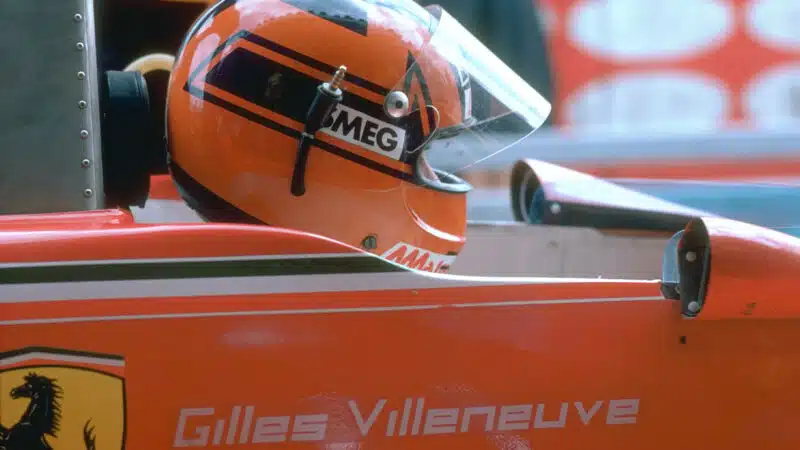
Gilles Villeneuve Ferrari US GP West Long Beach 1979
Mauro Foghieri says Villeneuve had a “rage to win”
Testing for his first GP with McLaren at Silverstone in 1977 was probably where the reputation for wildness took root. It’s now the stuff of legend how many times he spun. But it wasn’t clueless spinning; it was the result of a calculated strategy to get up to speed in time far qualifying in a car far more powerful than his Atlantics, on a track he didn’t know, and when there was only one chance to make a favourable impression. Not once did he hit anything; he chanced his arm only where he could recover, and his spin recovery was quite fantastic. Come qualifying and race, he was flawlessly polished and sensationally quick. With an obsolete M23, he set the race’s fifth-fastest lap, and had he disregarded the information of a faulty temperature gauge, he would have finished fourth.
Mega-talented though he was, he was still in over his head in terms of experience. If the McLaren run had been in at the deep end, stepping in at Ferrari later the same year as a short-notice replacement for the legendary Niki Lauda, and in a car that handled diabolically in the autumnal cold was akin to leaving the toddlers’ pool to swim in shark-infested waters. In Japan, his second race for the team, he messed up, getting airborne after misjudging a move on Ronnie Peterson. At this point, yes, he was wild.
“When he first arrived, his driving style was not really suitable for F1,” says Giacomelli, “or any single-seater, really. He was still quick, but the style made him have accident, too. But he learned and actually, though he remained spectacular, he became smooth as well. People get the two confused. You can still be super-smooth but be right on the limits, using all the track and more. People saw him pushing like hell because his cars weren’t competitive in 1980 and ’81 — up on the grass, crazy things — but I tell you, he was smooth in the way that he used the car, in the way he made the inputs into it. You could see that just watching his car.”
Carlos Reutemann, stunningly quick and with many years of experience, was Ferrari team leader in 1978 and performed brilliantly to win four races in an outdated car. His average performance was, not unexpectedly, higher than that of his rookie team-mate. But never did he take the fight to a fit and healthy ground-effect Lotus 79. Villeneuve did so twice — pressuring Mario Andretti for victory virtually all the way at Zolder and Monza. Which merely confirmed that his potential was off the scale.
His payback for the bad luck of Long Beach came in Canada thanks to the retirement, when well in front, of Jean-Pierre Jarier’s 79. But Gilles’ style was evidently smoothing out. How else did he make those soft Michelins — which even super-sensitive Reutemann shunned — last?
For 1979, Jody Scheckter came on board at Ferrari as the established superstar, the world champion elect. The plan was for Villeneuve’s second season to be one of support. He agreed, but in the first half of the year was conclusively quicker. His victory at Kyalami was a stunner, forcing a pace upon Jody that did for his tyres, overturning Scheckter’s logically ‘correct’ choice of slicks in a race that turned out to be only briefly wet Villeneuve had begun on wets. That shouldn’t have been the right strategy, but he made it so.
At Long Beach, he again trounced Scheckter, this time by going for another of his marginal compound choices and delicately making it work — from the front of the field throughout shouldn’t have been possible.
On the eve of the Belgian GP, Ferrari issued a statement to the effect that Scheckter had until Monaco, one race before the halfway point, to score a victory, otherwise the team would switch its championship effort to Villeneuve. Scheckter being Scheckter, won in Belgium — and Monaco. But the Belgian win was incredibly fortuitous, and with hindsight is the pivot upon which the perception of Villeneuve’s career stature swings. Scheckter made a clumsy first-lap passing attempt on Regazzoni at the chicane, the two making hefty contact. Jody got away without damage, but Regazzoni was cannoned into Villeneuve, who had to stop for a new nosecone and rejoin last. Gilles made a stunning comeback, his lap times showing that he could have dominated the race from the front. He was up to third when he ran out of fuel on the last lap. Even had he scored those four points — and not the nine Scheckter’s error probably cost him — Villeneuve would have been that year’s world champion, despite Scheckter’s number one treatment.
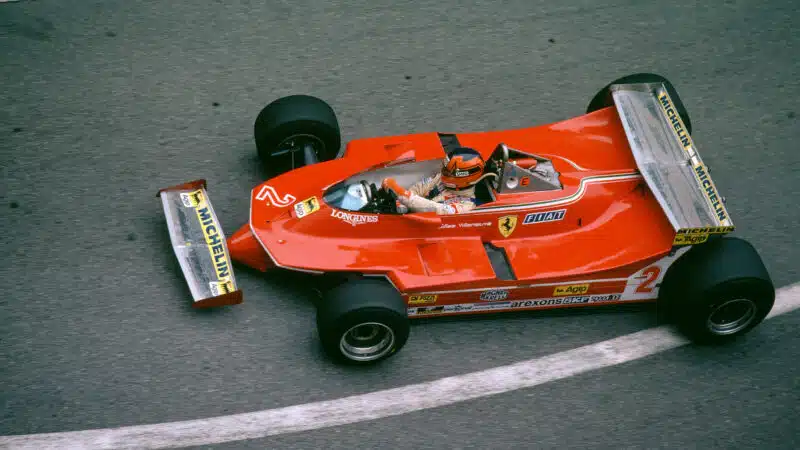
Gilles Villeneuve Ferrari Monaco GP West 1980
French-Canadian was renowned for being able to make even difficult cars dance on the limit
“I’ve read people say he couldn’t have won a championship,” says Giacomelli, “and I really don’t understand what they are talking about. He would have won in 79, but he handed it to Scheckter on team orders at Monza. He would have won in ’82, for sure, and he could have won many titles after that. No doubt about it.”
The mind boggles, in fact, at the statistics that might have been set had he not perished at Zolder ’82 and instead lived to accept Ron Dennis‘ repeated offer to join McLaren. Zandvoort 1979: the three-wheel incident, I hear you say. Totally irrelevant in assessing Villeneuve’s worth as a driver. The only reason he had damaged the rear end was that he had suffered a tyre blow-out while leading. Having passed Alan Jones‘ far superior Williams FW07 round the outside of Tarzan. He hadn’t made a mistake. Just as he hadn’t at Imola 1980: the famous accident after which that corner is now named. Again a tyre blow-out was the culprit.
Now consider this: in his four-and-a-bit years, 67 grands prix, he crashed out due to driver error no more than five times. Legend would suggest far more.
Now consider this: rock apes aren’t quick in the wet Watkins Glen 1979: wet first practice. Villeneuve was fastest by 8.5sec. Monaco 1980: a late-race downpour. Villeneuve was faster than anyone else by 5sec — in the hopeless 312T5.
Now consider this: crazy guys hanging on by their fingernails cannot sustain pressure from behind for any length of time. Jarama 1981: running at the front with four faster cars lined up behind him for virtually the entire distance. Not a single mistake. Not even the hint of one.
This was a very, very great driver indeed.
And that’s without even talking about the miracles. Putting a car that should really have struggled to qualify at all on the Monaco front row in 1981 — pipped by Nelson Piquet’s illegally light Brabham. Getting the T5 up to third place at Zandvoort in ’80, in a field of FW07s, BT49s, Ligiers and Renaults. Leading with it in Brazil and setting second-fastest lap. In underdog terms, that’s Senna, Moss and Nuvolari territory. All that and a Clark/Prost feel for tyres, too.
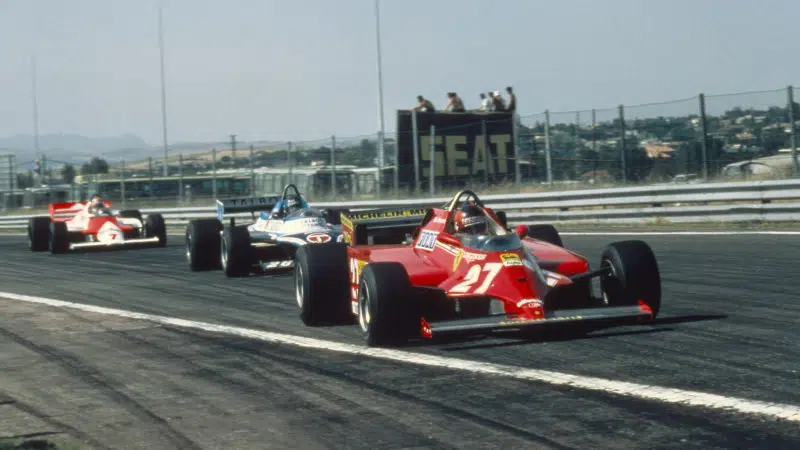
Villeneuve leads at Jarama ’81 with a hugely inferior car
“He wasn’t only fantastically quick,” says Giacomelli, “he had everything. He knew a lot of the technical side — in fact, he was a connoisseur of that. He knew exactly what the car was doing and he could talk about it very well. He was a very sensitive driver, actually.
“He was the greatest driver I ever saw.”
18th january 1950
Gilles Villeneuve was born.
(It was also my late Father's Birthday....today would have been his 98th. He was around for 93 of them.He was also a Gilles Fan)
Its been a while since I added anything in here , so, as today is Gilles Villeneuves Birthday seems a good opportunity to add something. I was reading this article about Gilles by Mark Hughes who writes to dispell the myth that Gilles frequently crashed, and indeed justifies some of those we all remember, like at Zandvoort. As a Gilles fan back in the day of course it was a must read article. I know we have other Gilles fans here (including our Emperor @PTRACER ) so here is the article, from the Motorsport Magazine archives just over 20 years ago.
Many of the actual tales here are well known, but told in a different way. There are some
Gilles Villenueve: A reckless reputation undeserved
Gilles Villeneuve was much more than a brilliant but flawed racer. Look beyond the popular myths, says Mark Hughes, and the evidence points to a style that was precise and an approach that was measured

Hughes argues that the common Villeneuve perception is unmerited
A long time ago there was a racing driver, a fantastic driver, who did many impossible things. He took his first GP victory — at the end of his first full season — by choosing a compound his tyre supplier said was way too soft. But he knew better; he had an uncanny feel for how to nurse the rubber but still conjure winning speed from it. His team-mate, renowned as one of the most sensitive drivers of all lime, knew he couldn’t make these tyres last, opted for the harder ones — and finished third.
The driver took his next victory early the following season by pushing his new team-mate hard enough to make him overwork his tyres. That done, he simply glided past and reeled off the remaining laps, untroubled, serene.
He took his third victory in the very next race by going a whole compound softer than his team-mate. Again, the tyre men drew sharp breaths and shook their heads. Again he confounded them, winning by over half a minute.
In the last race of that season he took win number four. This time he had to conserve a sick engine, its oil pressure almost non-existent for the last 20 laps.

Gilles Villeneuve Ferrari US GP West Long Beach 1979
Villeneuve had a reputation for going sideways – as well as fast
Who was this angel of simpatico with the touch of silk? Gilles Villeneuve, that’s who. Surely not? This is the man once described by Enzo Ferrari as “a high priest of destruction”, isn’t it?
The very same. It’s the driver, one of the fastest and most spectacular of all time, whose image is forever captured in racing minds for three-wheeling back to the pits at Zandvoort, or sitting in the middle of the track at Imola with not a wheel on his smouldering wreck.
The paradox is only superficial. Villeneuve was one of the greatest drivers the world has ever seen, of a calibre that comfortably compares to such accepted greats such as a Senna, Clark, Schumacher, Fangio or Moss. That’s not the general perception, because his life was cut short before the overwhelming glories that were his due ever got to play out. But it’s the reality. Look beneath the surface, beneath the snapshots of drama that have lasted more vividly than the subtleties, and the evidence is overwhelming.
Mauro Forghieri described Gilles as having a “rage to win” greater than any driver he had known, and it was this competitive intensity that drove him on. And that, allied to a twist of DNA, allowed him impossible victories like Monaco or Jarama 1981. It was this same rage, however, that sparked incident and spectacle when in 1980-81, at a time his career should have been coming into full flower, Ferrari provided him with dogs.
“He was an innocent believer,” says Forghieri. “He had surrendered his own chances [of the world championship] for the team in 1979 with Scheckter, and he believed that he would be paid back.” When circumstances conspired against that, desperation occasionally surfaced.
But what about before 1980-81? There was incident then, too, surely? Villeneuve’s close friend and fellow GP driver, Bruno Giacomelli, puts that into perspective: “You have to make the distinction between early in his career and later. Those who talk about Gilles as crazy, I think they got it wrong. You must remember that he had no real experience when he first came into F1. I mean, he didn’t even have international experience, just Formula Atlantic in Canada and North America. He had to learn so much more than the rest of us brought up on racing in Europe. If you think, he came to F1 without any international experience, he had to learn the tracks as well as all about F1 and with all the pressure of being a Ferrari driver.
“Of course he made mistakes! There were only two possible outcomes in that situation, no matter how talented you were. You would either not have been quick enough or you would have accidents. And if you’re not quick enough, you’re not going to get to stay in F1. So there was only one option. I think he did incredibly well. Jesus, he almost won one of his first races!” That would be Long Beach ’78, his sixth GP, a dominant victory lost only by failing to allow for Clay Regazzoni’s notoriously limited peripheral vision when he came up to lap him.

Gilles Villeneuve Ferrari US GP West Long Beach 1979
Mauro Foghieri says Villeneuve had a “rage to win”
Testing for his first GP with McLaren at Silverstone in 1977 was probably where the reputation for wildness took root. It’s now the stuff of legend how many times he spun. But it wasn’t clueless spinning; it was the result of a calculated strategy to get up to speed in time far qualifying in a car far more powerful than his Atlantics, on a track he didn’t know, and when there was only one chance to make a favourable impression. Not once did he hit anything; he chanced his arm only where he could recover, and his spin recovery was quite fantastic. Come qualifying and race, he was flawlessly polished and sensationally quick. With an obsolete M23, he set the race’s fifth-fastest lap, and had he disregarded the information of a faulty temperature gauge, he would have finished fourth.
Mega-talented though he was, he was still in over his head in terms of experience. If the McLaren run had been in at the deep end, stepping in at Ferrari later the same year as a short-notice replacement for the legendary Niki Lauda, and in a car that handled diabolically in the autumnal cold was akin to leaving the toddlers’ pool to swim in shark-infested waters. In Japan, his second race for the team, he messed up, getting airborne after misjudging a move on Ronnie Peterson. At this point, yes, he was wild.
“When he first arrived, his driving style was not really suitable for F1,” says Giacomelli, “or any single-seater, really. He was still quick, but the style made him have accident, too. But he learned and actually, though he remained spectacular, he became smooth as well. People get the two confused. You can still be super-smooth but be right on the limits, using all the track and more. People saw him pushing like hell because his cars weren’t competitive in 1980 and ’81 — up on the grass, crazy things — but I tell you, he was smooth in the way that he used the car, in the way he made the inputs into it. You could see that just watching his car.”
Carlos Reutemann, stunningly quick and with many years of experience, was Ferrari team leader in 1978 and performed brilliantly to win four races in an outdated car. His average performance was, not unexpectedly, higher than that of his rookie team-mate. But never did he take the fight to a fit and healthy ground-effect Lotus 79. Villeneuve did so twice — pressuring Mario Andretti for victory virtually all the way at Zolder and Monza. Which merely confirmed that his potential was off the scale.
His payback for the bad luck of Long Beach came in Canada thanks to the retirement, when well in front, of Jean-Pierre Jarier’s 79. But Gilles’ style was evidently smoothing out. How else did he make those soft Michelins — which even super-sensitive Reutemann shunned — last?
For 1979, Jody Scheckter came on board at Ferrari as the established superstar, the world champion elect. The plan was for Villeneuve’s second season to be one of support. He agreed, but in the first half of the year was conclusively quicker. His victory at Kyalami was a stunner, forcing a pace upon Jody that did for his tyres, overturning Scheckter’s logically ‘correct’ choice of slicks in a race that turned out to be only briefly wet Villeneuve had begun on wets. That shouldn’t have been the right strategy, but he made it so.
At Long Beach, he again trounced Scheckter, this time by going for another of his marginal compound choices and delicately making it work — from the front of the field throughout shouldn’t have been possible.
On the eve of the Belgian GP, Ferrari issued a statement to the effect that Scheckter had until Monaco, one race before the halfway point, to score a victory, otherwise the team would switch its championship effort to Villeneuve. Scheckter being Scheckter, won in Belgium — and Monaco. But the Belgian win was incredibly fortuitous, and with hindsight is the pivot upon which the perception of Villeneuve’s career stature swings. Scheckter made a clumsy first-lap passing attempt on Regazzoni at the chicane, the two making hefty contact. Jody got away without damage, but Regazzoni was cannoned into Villeneuve, who had to stop for a new nosecone and rejoin last. Gilles made a stunning comeback, his lap times showing that he could have dominated the race from the front. He was up to third when he ran out of fuel on the last lap. Even had he scored those four points — and not the nine Scheckter’s error probably cost him — Villeneuve would have been that year’s world champion, despite Scheckter’s number one treatment.

Gilles Villeneuve Ferrari Monaco GP West 1980
French-Canadian was renowned for being able to make even difficult cars dance on the limit
“I’ve read people say he couldn’t have won a championship,” says Giacomelli, “and I really don’t understand what they are talking about. He would have won in 79, but he handed it to Scheckter on team orders at Monza. He would have won in ’82, for sure, and he could have won many titles after that. No doubt about it.”
The mind boggles, in fact, at the statistics that might have been set had he not perished at Zolder ’82 and instead lived to accept Ron Dennis‘ repeated offer to join McLaren. Zandvoort 1979: the three-wheel incident, I hear you say. Totally irrelevant in assessing Villeneuve’s worth as a driver. The only reason he had damaged the rear end was that he had suffered a tyre blow-out while leading. Having passed Alan Jones‘ far superior Williams FW07 round the outside of Tarzan. He hadn’t made a mistake. Just as he hadn’t at Imola 1980: the famous accident after which that corner is now named. Again a tyre blow-out was the culprit.
Now consider this: in his four-and-a-bit years, 67 grands prix, he crashed out due to driver error no more than five times. Legend would suggest far more.
Now consider this: rock apes aren’t quick in the wet Watkins Glen 1979: wet first practice. Villeneuve was fastest by 8.5sec. Monaco 1980: a late-race downpour. Villeneuve was faster than anyone else by 5sec — in the hopeless 312T5.
Now consider this: crazy guys hanging on by their fingernails cannot sustain pressure from behind for any length of time. Jarama 1981: running at the front with four faster cars lined up behind him for virtually the entire distance. Not a single mistake. Not even the hint of one.
This was a very, very great driver indeed.
And that’s without even talking about the miracles. Putting a car that should really have struggled to qualify at all on the Monaco front row in 1981 — pipped by Nelson Piquet’s illegally light Brabham. Getting the T5 up to third place at Zandvoort in ’80, in a field of FW07s, BT49s, Ligiers and Renaults. Leading with it in Brazil and setting second-fastest lap. In underdog terms, that’s Senna, Moss and Nuvolari territory. All that and a Clark/Prost feel for tyres, too.

Villeneuve leads at Jarama ’81 with a hugely inferior car
“He wasn’t only fantastically quick,” says Giacomelli, “he had everything. He knew a lot of the technical side — in fact, he was a connoisseur of that. He knew exactly what the car was doing and he could talk about it very well. He was a very sensitive driver, actually.
“He was the greatest driver I ever saw.”
* I started life with nothing, and still have most of it left
“Good drivers have dead flies on the side windows!” (Walter Röhrl)
* I married Miss Right. Just didn't know her first name was Always
- Michael Ferner
- Senior Member

- Posts: 3531
- Joined: 7 years ago
- Real Name: Michael Ferner
- Favourite Racing Car: Miller '122', McLaren M23
- Favourite Driver: Billy Winn, Bruce McLaren
- Car(s) Currently Owned: None
- Location: Bitburg, Germany
Another rewrite of history by well known hagiographer Mark Hughes, a man on a mission. It's really becoming tiresome to read his BS over and over again, so sorry for not going into detail, but "angel of simpatico"?  I'm sorry, but I know that you shouldn't talk bad of the deceased, but I don't see why we should make saints of them, either. Villeneuve was not very likeable while he was alive, and he wasn't universally loved by Italians, either - I've seen manifest demonstrations of the opposite. And about his supposed "touch of silk", this about the man who not only crashed as a regular exercise but also destroyed more Ferrari transmissions than all other Ferrari drivers combined in thirty years. The ignorance of Mr. Hughes is actually laughable.
I'm sorry, but I know that you shouldn't talk bad of the deceased, but I don't see why we should make saints of them, either. Villeneuve was not very likeable while he was alive, and he wasn't universally loved by Italians, either - I've seen manifest demonstrations of the opposite. And about his supposed "touch of silk", this about the man who not only crashed as a regular exercise but also destroyed more Ferrari transmissions than all other Ferrari drivers combined in thirty years. The ignorance of Mr. Hughes is actually laughable.
2023 'Guess The Pole' Points & Accuracy Champion
If you don't vote now against fascism, you may never have that chance again...
If you don't vote now against fascism, you may never have that chance again...
Ceterum censeo interruptiones essent delendam.
- erwin greven
- Staff

- Posts: 20086
- Joined: 19 years ago
- Real Name: Erwin Greven
- Favourite Motorsport: Endurance Racing
- Favourite Racing Car: Lancia Delta 038 S4 Group B
- Favourite Driver: Ronnie Peterson
- Favourite Circuit: Nuerburgring Nordschleife
- Car(s) Currently Owned: Peugeot 206 SW Air-Line 3 2007
- Location: Stadskanaal, Groningen
- Contact:
In the 1978 season, pretty much every Ferrari mechanic wondered if he was the right one for them. So much carnage he did to the resources. Transmissions was one thing, but also suspensions, floors, wings... As you say he was not universal popular. And that was also within the Ferrari squad. For someone who is "the fastest of his generation" he won way to few GP. And crashed a ton of cars.Michael Ferner wrote: ↑3 months ago Another rewrite of history by well known hagiographer Mark Hughes, a man on a mission. It's really becoming tiresome to read his BS over and over again, so sorry for not going into detail, but "angel of simpatico"?I'm sorry, but I know that you shouldn't talk bad of the deceased, but I don't see why we should make saints of them, either. Villeneuve was not very likeable while he was alive, and he wasn't universally loved by Italians, either - I've seen manifest demonstrations of the opposite. And about his supposed "touch of silk", this about the man who not only crashed as a regular exercise but also destroyed more Ferrari transmissions than all other Ferrari drivers combined in thirty years. The ignorance of Mr. Hughes is actually laughable.
Brian Redman: "Mr. Fangio, how do you come so fast?" "More throttle, less brakes...."
- MonteCristo
- Moderator

- Posts: 10730
- Joined: 8 years ago
- Favourite Motorsport: Openwheel
- Favourite Racing Car: Tyrrell P34/Protos
- Favourite Driver: JV
- Favourite Circuit: Road America
- Location: Brisbane, Australia
Someone needed an article during the offseason.
Oscar Piastri in F1! Catch the fever! Vettel Hate Club. Life membership.
2012 GTP Non-Championship Champion | 2012 Guess the Kai-Star Half Marathon Time Champion | 2018 GTP Champion | 2019 GTP Champion
2012 GTP Non-Championship Champion | 2012 Guess the Kai-Star Half Marathon Time Champion | 2018 GTP Champion | 2019 GTP Champion
- Everso Biggyballies
- Legendary Member

- Posts: 49403
- Joined: 18 years ago
- Real Name: Chris
- Favourite Motorsport: Anything that goes left and right.
- Favourite Racing Car: Too Many to mention
- Favourite Driver: Kimi,Niki,Jim(none called Michael)
- Favourite Circuit: Nordschleife, Spa, Mt Panorama.
- Car(s) Currently Owned: Audi SQ5 3.0L V6 TwinTurbo
- Location: Just moved 3 klms further away so now 11 klms from Albert Park, Melbourne.
On This Day..... 26th February 1908......
.....Jean-Pierre Wimille was born

Something of a hero, who sadly died the year before the advent of the World Drivers Championship in 1950. But Wimille was so much more thsn a racing driver of note.
He was a notable French Resistance fighter as well as a pre-war racing ace.. He was a hero both on and off the track. Sadly, the Frenchman's results do not reflect the true scale of his talent.
Born in Paris, France to a father who loved motor sports and was employed as the motoring correspondent for the Petit Parisien newspaper, Jean-Pierre Wimille developed his fascination with racing cars at a young age. He was 22 years old when he made his Grand Prix debut, driving a Bugatti 37A at the 1930 French Grand Prix in Pau.
Driving a Bugatti T51, in 1932 he won the La Turbie Mountain Race, the Grand Prix de Lorraine and the Grand Prix d'Oran. In 1934 he was the victor at the Algerian Grand Prix in Algiers driving a Bugatti T59 and in January of 1936 he finished second in the South African Grand Prix held at the Prince George Circuit in East London, South Africa then won the French Grand Prix in his home country.
Still in France, that same year he won the Deauville Grand Prix, a race held on the city's streets. Wimille won in his Bugatti T59 in an accident-marred race that killed drivers Raymond Chambost and Marcel Lehoux in separate incidents. Of the 16 cars that started the race, only three managed to finish.
In 1936, Wimille traveled to Long Island, New York to compete in the Vanderbilt Cup where he finished 2nd, behind the winner, Tazio Nuvolari.
Wimille also competed in the 24 hours of Le Mans endurance race, winning in 1937 and again in 1939. In the 1937 win he shared a Bugatti "Tank" with Robert Benoist. This victory marked the start of a great friendship between the two men.
When World War II came, following the Nazi occupation Wimille and fellow Grand Prix race drivers Robert Benoist and William Grover-Williams joined the Special Operations Executive of the French Resistance. Of the three, Wimille was the only one to survive.
Jean-Pierre Wimille married Christiane de la Fressange with whom he had a son, François born in 1946. At the end of the War, he became the No. 1 driver for the Alfa Romeo team between 1946 and 1948, winning several Grand Prix races including his second French Grand Prix. Jean-Pierre Wimille died at the wheel of a racing car during practice runs for the 1949 Buenos Aires Grand Prix.
Here is a illustrated comic like strip of his life story published in Motorsport Magazine. If you want to read more of Wimille an his fellow Grand Pric driving resistance fighters I highly recommend Joe Sawards fine and painstakingly researched book the Grand Prix Saboteurs.
He won 22 competitions, including some of the most legendary such as the Le Mans 24 hours, the Coupe de Paris, the Grand Prix Dell ‘ Autodromo on the Monza circuit, the European Grand Prix in Spa, the ACF Grand Prix in Montlhéry, among many others. In the Spanish Grand Prix in 1935, he came fourth after a bitter duel, just behind the three super-powerful Mercedes Silver Arrows, leaving behind him the formidable Auto Union V16 driven by the no less formidable Bernd Rosemeyer . Jean Pierre Wimille was well known among the greatest racing drivers in the world.
Some of Jean-Pierre Wimille's race victories:
1932:
Grand Prix de Lorraine
Grand Prix d'Oran
1934:
Grand Prix of Algeria - Bugatti T59
1936:
French Grand Prix - Bugatti T57G
Grand Prix de la Marne - Bugatti T57G
Deauville Grand Prix - Bugatti T59
Grand Prix du Comminges - Bugatti T59/57
1937:
Grand Prix de Pau - Bugatti T57G (The Tank)
Grand Prix de Böne - Bugatti T57
24 hours of Le Mans - Bugatti T57G driving with Robert Benoist
Grand Prix de la Marne - Bugatti T57
1939:
Coupe de Paris
Grand Prix du Centenaire Luxembourg - Bugatti T57S45
24 hours of Le Mans - Bugatti T57C driving with Pierre Veyron
Post War - 1945:
Coupe des Prisonniers - Bugatti sprint car
1946:
Coupe de la Résistance - Alfa Romeo 308
Grand Prix de Roussillon - Alfa Romeo 308
Grand Prix de Bourgogne - Alfa Romeo 308
Grand Prix des Nations (Heat 1) - Alfa Romeo 158
1947:
Swiss Grand Prix - Alfa Romeo 158
Belgian Grand Prix - Alfa Romeo 158
Coupe de Paris
1948:
Grand Prix de Rosario - Simca- Gordini 15
French Grand Prix - Alfa Romeo 158
Italian Grand Prix - Alfa Romeo 158
Autodrome Grand Prix - Alfa Romeo 158/47
Of course a few additional photos .....
The road cars he started to develop was lets say futuristic given the times.



Thw somewhat peculiar looking car in the pic above was equipped with a 2 litre Citroen motor mid mounted.... it produced 56bhp
Amazingly the body had a drag coefficient of only 0.23... it had a top speed of 150 kph wwhich was some accomplishment back in 1946. Most cars today dont meet those minimal levels of drag..

This car below was shown off at the Paris Retromobile Show in 2018

Jean Pierre Wimille and Pierre Veyron winning the 24 Heures du Mans in 1939 in a Bugatti Type 57C


The Le Mans winning Bugatti Tank he shared with Benoist in 1937.



Here is Wimille competing at Prescott in the UK back in 1939
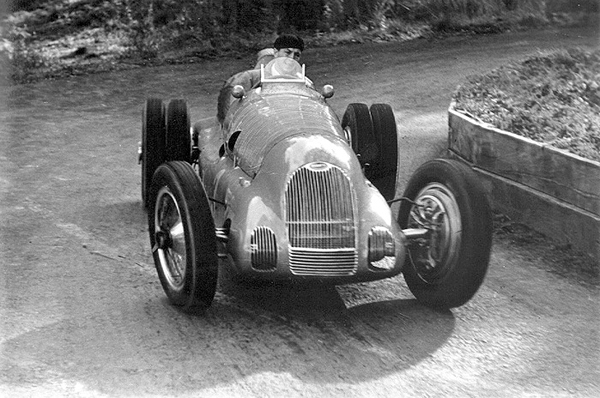
For nfo a pic of the original Bugatti type 32 tank from the early twenties
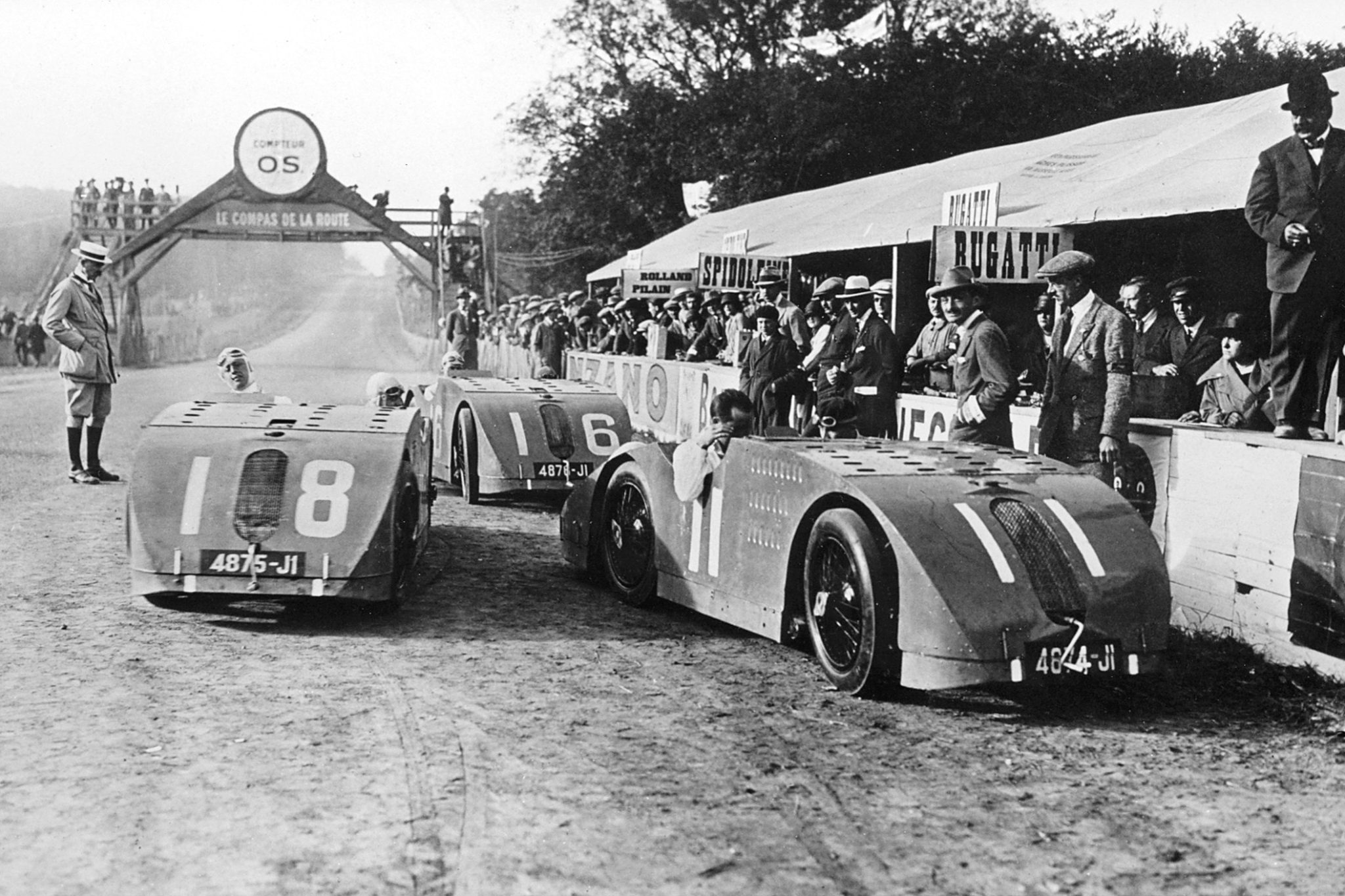
On July 30, 1939 the Bugatti Owners Club, which often ran competitions at the Prescott Hill-climb, near Cheltenham in the Cotswolds, held an international level event. The recent and double Le Mans winner Jean-Pierre Wimille (above wearing a beret) was entered by the Bugatti factory in a unique monoposto Bugatti 50B which used a supercharged 4.7 liter engine in a modified Type 59 chassis. Jean Bugatti, son of the firm’s founder, was also in attendance. Double rear wheels had been fitted to Wimille’s car, as was common at the time in British hill-climbs to give better traction.
He also drove for Alfa.... Wimille in a 158 in 1948
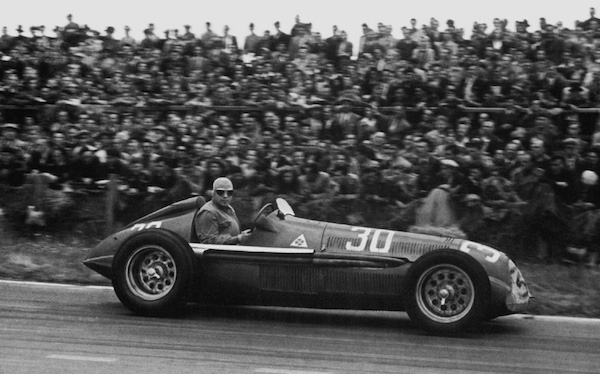
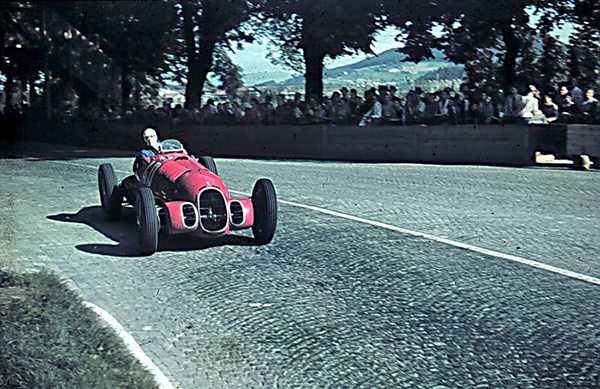
Jean-Pierre Wimille in an Alfa Romeo 312, a supercharged three litre V12, entered by the works team Alfa Corse, during practice for the 1938 Swiss Grand Prix on the Bremgarten circuit in Bern.
.....Jean-Pierre Wimille was born

Something of a hero, who sadly died the year before the advent of the World Drivers Championship in 1950. But Wimille was so much more thsn a racing driver of note.
He was a notable French Resistance fighter as well as a pre-war racing ace.. He was a hero both on and off the track. Sadly, the Frenchman's results do not reflect the true scale of his talent.
Born in Paris, France to a father who loved motor sports and was employed as the motoring correspondent for the Petit Parisien newspaper, Jean-Pierre Wimille developed his fascination with racing cars at a young age. He was 22 years old when he made his Grand Prix debut, driving a Bugatti 37A at the 1930 French Grand Prix in Pau.
Driving a Bugatti T51, in 1932 he won the La Turbie Mountain Race, the Grand Prix de Lorraine and the Grand Prix d'Oran. In 1934 he was the victor at the Algerian Grand Prix in Algiers driving a Bugatti T59 and in January of 1936 he finished second in the South African Grand Prix held at the Prince George Circuit in East London, South Africa then won the French Grand Prix in his home country.
Still in France, that same year he won the Deauville Grand Prix, a race held on the city's streets. Wimille won in his Bugatti T59 in an accident-marred race that killed drivers Raymond Chambost and Marcel Lehoux in separate incidents. Of the 16 cars that started the race, only three managed to finish.
In 1936, Wimille traveled to Long Island, New York to compete in the Vanderbilt Cup where he finished 2nd, behind the winner, Tazio Nuvolari.
Wimille also competed in the 24 hours of Le Mans endurance race, winning in 1937 and again in 1939. In the 1937 win he shared a Bugatti "Tank" with Robert Benoist. This victory marked the start of a great friendship between the two men.
When World War II came, following the Nazi occupation Wimille and fellow Grand Prix race drivers Robert Benoist and William Grover-Williams joined the Special Operations Executive of the French Resistance. Of the three, Wimille was the only one to survive.
Jean-Pierre Wimille married Christiane de la Fressange with whom he had a son, François born in 1946. At the end of the War, he became the No. 1 driver for the Alfa Romeo team between 1946 and 1948, winning several Grand Prix races including his second French Grand Prix. Jean-Pierre Wimille died at the wheel of a racing car during practice runs for the 1949 Buenos Aires Grand Prix.
Here is a illustrated comic like strip of his life story published in Motorsport Magazine. If you want to read more of Wimille an his fellow Grand Pric driving resistance fighters I highly recommend Joe Sawards fine and painstakingly researched book the Grand Prix Saboteurs.
https://www.motorsportmagazine.com/arch ... ife-story/
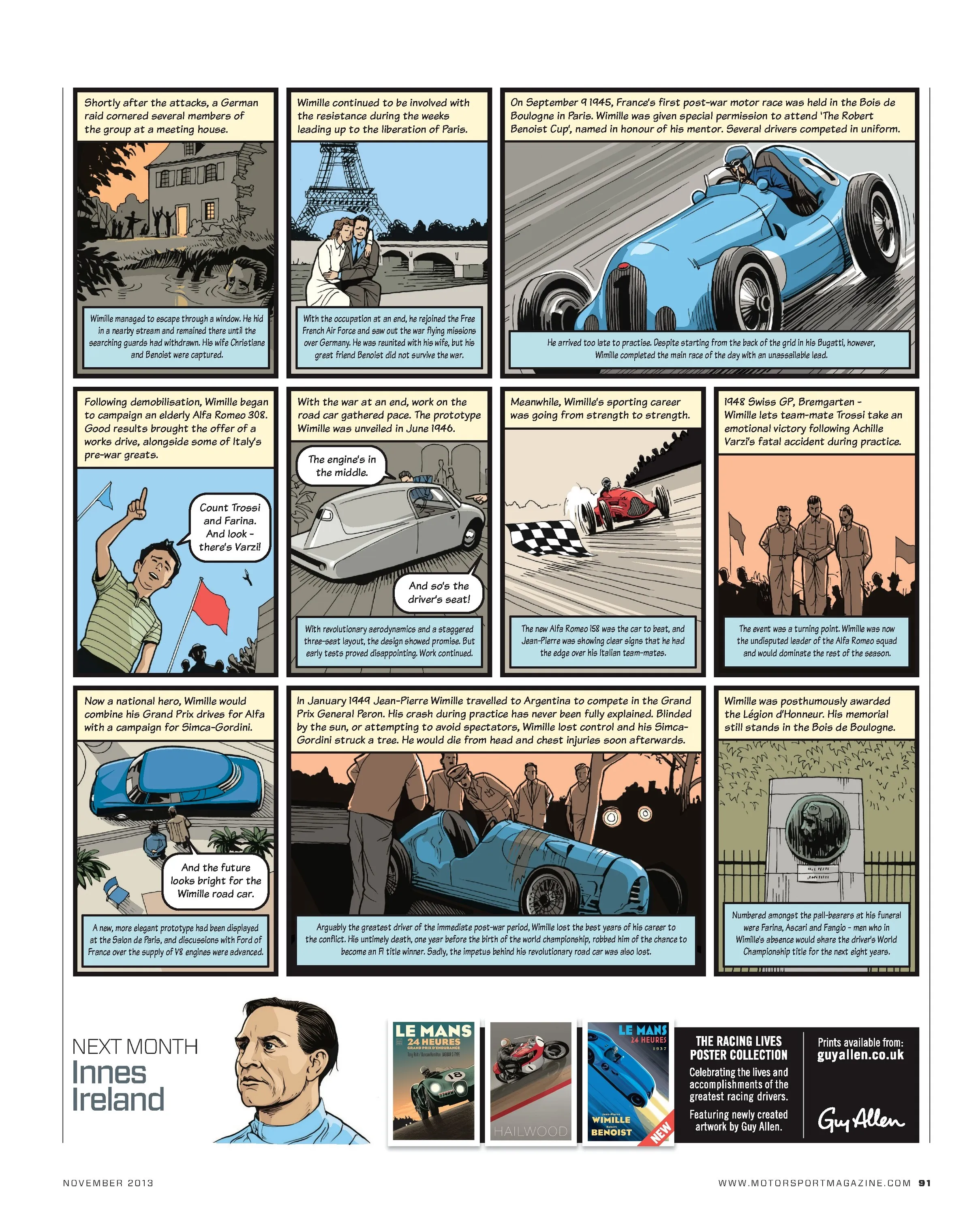
He won 22 competitions, including some of the most legendary such as the Le Mans 24 hours, the Coupe de Paris, the Grand Prix Dell ‘ Autodromo on the Monza circuit, the European Grand Prix in Spa, the ACF Grand Prix in Montlhéry, among many others. In the Spanish Grand Prix in 1935, he came fourth after a bitter duel, just behind the three super-powerful Mercedes Silver Arrows, leaving behind him the formidable Auto Union V16 driven by the no less formidable Bernd Rosemeyer . Jean Pierre Wimille was well known among the greatest racing drivers in the world.
Some of Jean-Pierre Wimille's race victories:
1932:
Grand Prix de Lorraine
Grand Prix d'Oran
1934:
Grand Prix of Algeria - Bugatti T59
1936:
French Grand Prix - Bugatti T57G
Grand Prix de la Marne - Bugatti T57G
Deauville Grand Prix - Bugatti T59
Grand Prix du Comminges - Bugatti T59/57
1937:
Grand Prix de Pau - Bugatti T57G (The Tank)
Grand Prix de Böne - Bugatti T57
24 hours of Le Mans - Bugatti T57G driving with Robert Benoist
Grand Prix de la Marne - Bugatti T57
1939:
Coupe de Paris
Grand Prix du Centenaire Luxembourg - Bugatti T57S45
24 hours of Le Mans - Bugatti T57C driving with Pierre Veyron
Post War - 1945:
Coupe des Prisonniers - Bugatti sprint car
1946:
Coupe de la Résistance - Alfa Romeo 308
Grand Prix de Roussillon - Alfa Romeo 308
Grand Prix de Bourgogne - Alfa Romeo 308
Grand Prix des Nations (Heat 1) - Alfa Romeo 158
1947:
Swiss Grand Prix - Alfa Romeo 158
Belgian Grand Prix - Alfa Romeo 158
Coupe de Paris
1948:
Grand Prix de Rosario - Simca- Gordini 15
French Grand Prix - Alfa Romeo 158
Italian Grand Prix - Alfa Romeo 158
Autodrome Grand Prix - Alfa Romeo 158/47
Of course a few additional photos .....
The road cars he started to develop was lets say futuristic given the times.

.https://www.prewarcar.com/retromobile-t ... re-wimilleHe recalled the motor vehicle exhibition of 1937 where he had previously considered the idea of the car of the future. He had sketched out the main lines of this project, shattering the principles of legendary manufacturers. A fast, lightweight car was required with a powerful engine but low cylinder capacity and above all, a structure integrated into a fully aerodynamic body. With the help of his engineer and mechanic friends, he was to realise his plan during this wartime period. A tubular structure, engine and central steering. It was not far from the formula 1 configuration!
A streamlined body was designed with a panoramic windscreen, integrated headlights, independent wheels and electrical control gear box. Three versions were already planned, a 70hp Grand Tourisme; the Sport, with a 100hp V6 1,500cm3 engine; and a 220hp racing version expected to reach speeds of almost 300km/h. This was how the Wimille GT came into being on paper in 1943.
1946, the first appearance of the Wimille 01 prototype was an immediate success. The car’s shape and design was revolutionary. Due to lack of time, the V6 engine planned was replaced by a Citroën Traction engine, which made it possible to conduct initial tests over long distances and present it officially in 1946.


Thw somewhat peculiar looking car in the pic above was equipped with a 2 litre Citroen motor mid mounted.... it produced 56bhp
Amazingly the body had a drag coefficient of only 0.23... it had a top speed of 150 kph wwhich was some accomplishment back in 1946. Most cars today dont meet those minimal levels of drag..

This car below was shown off at the Paris Retromobile Show in 2018

Jean Pierre Wimille and Pierre Veyron winning the 24 Heures du Mans in 1939 in a Bugatti Type 57C


The Le Mans winning Bugatti Tank he shared with Benoist in 1937.



Here is Wimille competing at Prescott in the UK back in 1939

For nfo a pic of the original Bugatti type 32 tank from the early twenties

On July 30, 1939 the Bugatti Owners Club, which often ran competitions at the Prescott Hill-climb, near Cheltenham in the Cotswolds, held an international level event. The recent and double Le Mans winner Jean-Pierre Wimille (above wearing a beret) was entered by the Bugatti factory in a unique monoposto Bugatti 50B which used a supercharged 4.7 liter engine in a modified Type 59 chassis. Jean Bugatti, son of the firm’s founder, was also in attendance. Double rear wheels had been fitted to Wimille’s car, as was common at the time in British hill-climbs to give better traction.
He also drove for Alfa.... Wimille in a 158 in 1948


Jean-Pierre Wimille in an Alfa Romeo 312, a supercharged three litre V12, entered by the works team Alfa Corse, during practice for the 1938 Swiss Grand Prix on the Bremgarten circuit in Bern.
* I started life with nothing, and still have most of it left
“Good drivers have dead flies on the side windows!” (Walter Röhrl)
* I married Miss Right. Just didn't know her first name was Always
